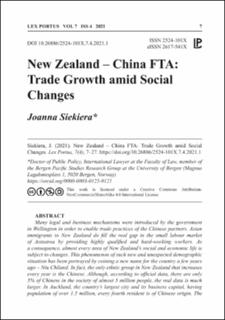| dc.contributor.author | Siekiera, Joanna | |
| dc.date.accessioned | 2021-09-23T11:00:54Z | |
| dc.date.available | 2021-09-23T11:00:54Z | |
| dc.date.created | 2021-09-16T17:08:09Z | |
| dc.date.issued | 2021 | |
| dc.identifier.issn | 2524-101X | |
| dc.identifier.uri | https://hdl.handle.net/11250/2780748 | |
| dc.description.abstract | Many legal and business mechanisms were introduced by the government in Wellington in order to enable trade practices of the Chinese partners. Asian immigrants to New Zealand do fill the real gap in the small labour market of Aotearoa by providing highly qualified and hard-working workers. As a consequence, almost every area of New Zealand’s social and economic life is subject to changes. This phenomenon of such new and unexpected demographic situation has been portrayed by coining a new name for the country a few years ago – Niu Chiland. In fact, the only ethnic group in New Zealand that increases every year is the Chinese. Although, according to official data, there are only 5% of Chinese in the society of almost 5 million people, the real data is much larger. In Auckland, the country’s largest city and its business capital, having population of over 1.5 million, every fourth resident is of Chinese origin. The Free Trade Agreement turned out to be a breakthrough, as Wellington was the first capital among developed Western countries that decided to legally bind itself with the People’s Republic of China in 2008. In 2021, China and New Zealand signed the Protocol to amend the New Zealand-China agreement and to add some previously not taken into consideration spheres, such as e-commerce and environment. While New Zealand economy clearly shows benefits of trade with China, and anyhow sees any potential negative effects, like political dependence from this communist state not respecting human rights, between the politicians in Canberra and Beijing there continue to escalate tensions. Australia, contrary to New Zealand, is trying to contain Chinese imperialist’s appetite and stop Beijing before launching own sphere of interest in the Pacific region. | en_US |
| dc.language.iso | eng | en_US |
| dc.publisher | National University "Odessa Law Academy" | en_US |
| dc.rights | Navngivelse-Ikkekommersiell-DelPåSammeVilkår 4.0 Internasjonal | * |
| dc.rights.uri | http://creativecommons.org/licenses/by-nc-sa/4.0/deed.no | * |
| dc.title | New Zealand – China FTA: Trade Growth amid Social Changes | en_US |
| dc.type | Journal article | en_US |
| dc.type | Peer reviewed | en_US |
| dc.description.version | publishedVersion | en_US |
| cristin.ispublished | true | |
| cristin.fulltext | original | |
| cristin.qualitycode | 1 | |
| dc.identifier.doi | https://doi.org/10.26886/2524-101X.7.4.2021.1 | |
| dc.identifier.cristin | 1935091 | |
| dc.source.journal | Lex Portus | en_US |
| dc.source.pagenumber | 7-27 | en_US |
| dc.relation.project | Norges forskningsråd: 275312 | en_US |
| dc.identifier.citation | Lex Portus. 2021, 7 (4), 7-27. | en_US |
| dc.source.volume | 7 | en_US |
| dc.source.issue | 4 | en_US |

